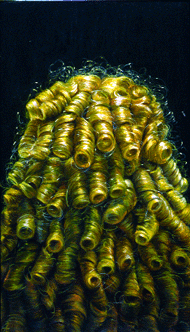Bellwether Gallery show based on late 19th century portrayals of women is a conservative re-tread
As an entry in the summer group show category, “Idols of Perversity” at Bellwether Gallery in Chelsea has been widely reviewed. But I couldn’t let this show pass without offering my own two cents.
Curator Thomas Woodruff, the dean of the illustration department at the School of Visual Arts who included his own work in this exhibition, and gallery owner Becky Smith based this show on Bram Dijkstra’s 1986 “Idols of Perversity—Fantasies of Feminine Evil in Fin de Sièle Culture,” which critiques the portrayal of women’s images in late 19th century painting and drawing. Owing to an abiding fear that women were gaining undeserved power culturally, they were often portrayed as evil, vain temptresses leading good men to hell.
Each work in this show uses that perspective as a stepping-off point, depicting women in this way—and even men, in a few cases—painted in an ostensibly symbolist style. This style of painting was soon overtaken by Impressionism, Expressionism and in time Cubism.
In its era, this kind of painting was looked down upon—and with this show we can see why.
Leading the pack, as it were, in this show is a painting of a bald woman by John Currin. This painting depicts a chemotherapy-induced portrait of a woman that would typically be hidden from public view with a wig, or at least would have been until Melissa Etheridge made the look more acceptable. Currin’s attention to the material considerations of the paint and his drawing skill save this piece from falling into the cynical, “wink, wink” trap that many of the other works in the show suffer.
In fact, most of the other works are poor imitations of the Currin school of painting. When everything starts looking the same in the galleries, the movement is very close to being over, and thank god, I say. How many big-eyed girl paintings do we have to look at? It’s probably more accurate to say that Walter Keane is the leader of this pack.
Fortunately, there are a few exceptions. Duncan Hannah has several paintings throughout the gallery that resemble 1940s and ‘50s illustrations of women sleeping—a dressed woman, a naked woman and a woman brushing her hair in front of a fauves painting. His work reads differen—because his painting abilities support the images chosen and he has the right attitude—sincere but aware of where his images are coming from. Graham Little’s portrait of a super-model holds up and doesn’t seem like just a private joke. Ruth Martin’s painting of the curls on the back of a woman’s head that fill the whole canvas, in the vein of work by Lorna Simpson, demonstrates the skill to pull off the detailed image.
Despite the bright spots, the bulk of the work in this show seems to have been included because they demonstrated skill at illustration but with dumbed-down, though stylized subject matter that made them suitable for greeting cards. With an academic veneer, the message seems to be, “Oh, here’s a new edge to push at. Aren’t we hip?”
Are they trying to shock us?
With a few exceptions, this show could be called “Idols of Illustration.”
Isn’t this just another conservative show expounding conventional ideas about painting, perversion, gays and women?
gaycitynews.com


































